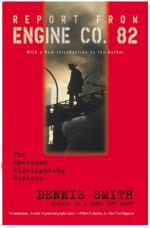
|
| Name: _________________________ | Period: ___________________ |
This test consists of 15 multiple choice questions and 5 short answer questions.
Multiple Choice Questions
1. Where was the last false alarm of the day called from, at the end of Chapter 5?
(a) Manhattan Road.
(b) Long Island Road.
(c) Boston Road.
(d) Trenton Road.
2. Why was his wife upset the morning Smith went back to work?
(a) She had lost her job.
(b) She wanted to move closer to the city.
(c) She was worried about the kids.
(d) She had talked to his mother about the dangers of his job.
3. What were the "high incidence hours" that Tactical Control Unit 712 became responsible for?
(a) 6 a.m. and 4 p.m.
(b) 3 p.m. and 1 a.m.
(c) Noon and 10 p.m.
(d) 6 p.m. and 4 a.m.
4. On what street did the firefighters respond to a large fire in Chapter 5?
(a) Carlotti Street.
(b) Charlotte Street.
(c) Broad Street.
(d) Campanella Avenue.
5. What was the name of the strong fireman who single-handedly replaced the hose at the end of Chapter 5?
(a) Knipps.
(b) Billy Valenzia.
(c) Benny Carroll.
(d) Royce.
6. Whose job is it to investigate suspicious fires?
(a) Fire marshals.
(b) Fire investigators.
(c) The fire chief.
(d) Arson specialists.
7. What does Smith say computers can be used for in the firefighting field?
(a) Computers can project how many fires will occur in a given day.
(b) Computers can be used to reduce response times.
(c) Computers can help firefighters determine the best way to fight a fire.
(d) Computers can help fire trucks find fires faster.
8. What did Smith consider the most admirable characteristic of firefighters?
(a) Their committment to community.
(b) Their strength.
(c) Their bravery.
(d) Their reliability.
9. In which city did Smith serve?
(a) Los Angeles.
(b) New York City.
(c) Chicago.
(d) Boston.
10. How do firefighters get enough oxygen when a building is thick with smoke?
(a) By using oxygen tanks.
(b) By crawling on their stomachs to reach the oxygen at floor level.
(c) By breaking out windows to get oxygen in.
(d) By first clearing out some of the smoke.
11. Who was responsible for the most malicious false alarms?
(a) Children.
(b) Criminals.
(c) Teenagers.
(d) Adults.
12. What injury did the young Hispanic boy suffer during the dinner time call to Home and Simpson streets?
(a) A broken leg.
(b) A broken arm.
(c) A broken neck.
(d) Abrasions and bruises.
13. What happened to several firefighters (including Smith) fighting a blaze at a two-story factory building?
(a) The roof caved in.
(b) The windows began breaking.
(c) The floor gave away.
(d) A fire broke out behind them.
14. In what town did Smith live while working in the South Bronx?
(a) New Paltz.
(b) Scarsdale.
(c) Flushing.
(d) Washingtonville.
15. What was the average daily number of false alarms in New York City during the time period covered by the book?
(a) 50.
(b) 147.
(c) 250.
(d) 100.
Short Answer Questions
1. Which Irish writer did Smith discuss in his letter to the editor?
2. In Smith's view, what needed to happen before people stopped assaulting firefighters?
3. What did the kids across the street from the Union Avenue fire do when the firefighters arrived?
4. How was a firefighter injured while rescuing a child from a fire on Prospect Avenue?
5. What options did the firefighters have when they were trapped between the two blazes at the factory building?
|
This section contains 607 words (approx. 3 pages at 300 words per page) |

|




